Road Signs are divided into four general categories, Regulatory Road Signs, Warning Road Signs, Information Road Signs and Motorway Road Signs.
To get a complete list of all Irish Road Signs download your free copy of the Rules of the Road here
1. Regulatory Road Signs
Regulation signs are road signals that require a driver to obey a specific order. They are also called traffic control signage.
This is the most important signage category for drivers who are new in town as they serve as guide for them not to break traffic rules that could attract stiff sanctions.
They include the following
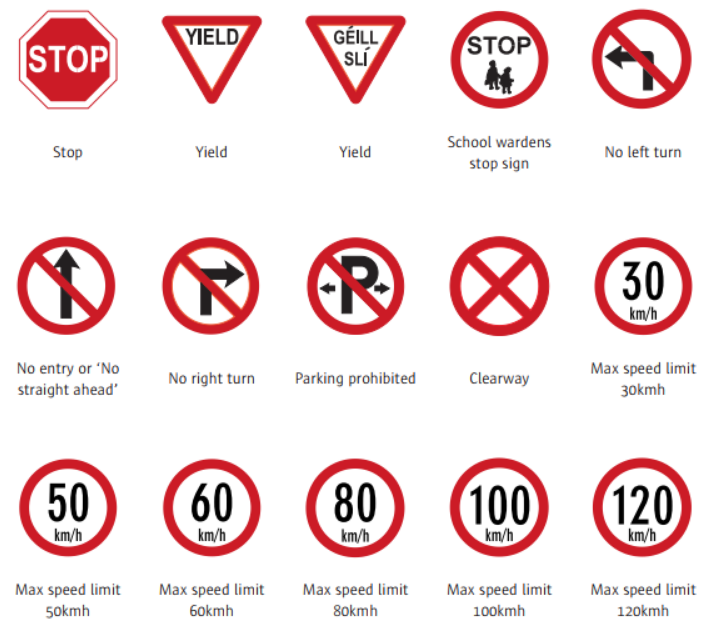
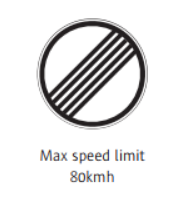
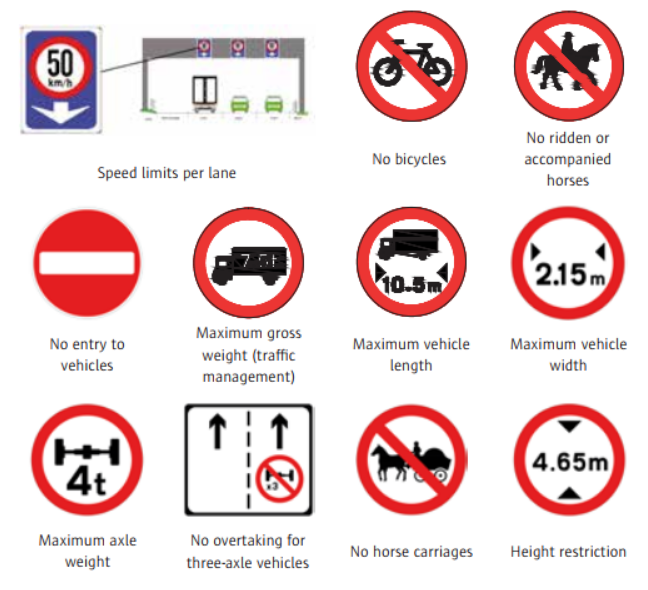

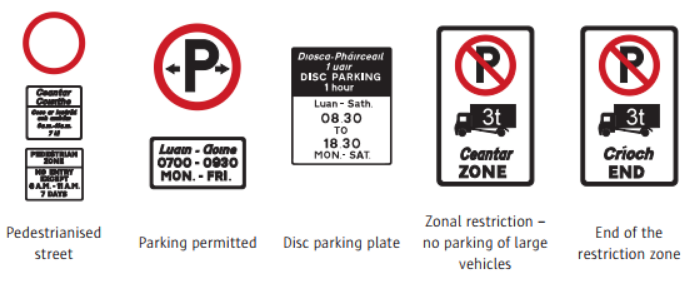
Mandatory signs at junctions: these are usually in white and blue colours.

2. Warning Road Signs

Dangerous corner: Road configuration is something you can’t really predict if you are driving for the first time. No matter how safe a road may look, you can always expect to meet up with a sharp corner, which is a potentially dangerous road configuration.
The road sign of a dangerous corner is in the form of a right-angle pointer. Usually, it points in the direction in which the bend in question heads.
This will help road users have an idea of which side of the road the bent is tilted to and how sharp it is.
Whenever you see a warning sign of this nature, it is best for you to drop down the speed of the vehicle and pay more than usual attention to the road configuration; driving accordingly.
Roundabout ahead: roundabouts are an integral part of roads in many countries. Ireland is not an exemption. There are roundabouts even in rural areas and in highbrow areas, we have complex road structures which include roundabouts.
A roundabout warning sign usually comes in the form of three round pointers that gives them a general look of a circle of the same diameter.
Once you see this, you should have it in mind that you are approaching a major roundabout.
Therefore, it is expected that you drop your speed and anticipate the situation you are going to encounter getting to the roundabout.
Mini roundabout: this is quite different from the type of roundabout earlier described, the size of a roundabout is very important to the attitude of the driver plying the road it determines the attitude of drivers on the road.
Hence, in addition to identifying a roundabout warning sign on the road, it is vital that you have an idea of how big it is.
A mini-roundabout warning sign has a dot in the middle, then surrounded by three curved lines towing the same diameter, making it look like a circle with three broken lines. However, the curved lines are with small arrows or pointers as described in the main roundabout warning sign.
Once you see something of this nature, you can expect to meet a not-so-busy roundabout. However, you still want to be careful and reduce your speed as you approach it.
Merging traffic: in busy areas, you get to see two busy roads merging in a slanted format. You get to see that it is not really a T junction. Usually, the receiving lane is a one-way lane.
Once you are about to get to a road with this configuration, it is always vital to slow down your speed.
However, many drivers feel this is not a junction; hence, they tend to just transit at the same speed level.
That is why you get to see a warning signal for roads of this configuration so drivers can be mindful of their speed as they approach merging traffic.
Two-way traffic: this can also be known as a double lane. It is not uncommon to see two standard roads side by side, demarcated with a constructed concrete ridge that houses large street lamps in Irish cities.
When you are approaching a road of this configuration, you get to see a warning sign of two arrows lying side by side but pointing in different directions.
On seeing this, drivers are expected to configure their minds to comply with the rules associated with driving on roads with this configuration.
For example, they should know when they need to be in the fast lane or slow lane. Again, they want to exercise caution in transiting from a fast to a slow lane or vice versa.
Dangerous bend ahead: Don’t get confused, there is actually a difference between a dangerous corner and a dangerous bend. The difference is that one is a bend and the other is a corner.
While a corner is quite gentle in its diversion, a bend is way Swiffer. For a dangerous bend, its sigh looks exactly like a gently bending arrow.
In essence, you want to exercise a more significant deal of patience when approaching a dangerous corner. In the case of a bend, you want to be careful too by dropping your speed while you ply the bending part of the road.
Series of dangerous bends ahead: some road configurations can be really complex. You find roads like this in areas with rough topography, such as undulating mountains that are sometimes characterised by clumsy water bodies.
In cases like this, road designers are usually short of options in their quest to deliver easily navigable roads. This gives birth to a set of dangerous bends.
Once this is the situation, the only option to maintain road safety is by cautioning road users via a warning traffic sign that reads “series of dangerous roads ahead.” This sign is usually in the form of a snake-like arrow, signifying multiple bends.
It is not uncommon for roads like this to be accompanied by multiple bumps. This is usually done in a bid to force reckless drivers to drop their speed while they navigate the bends.
Restricted headroom: some axis or areas are mindful of the type of vehicle allowed into them. Most of the time, reasons for this restriction might be road capability or even security in some cases.
For roads like this, you get to see road signs, including the specific height of restricted vehicles, if your vehicle is a bit longer than the benchmark height; you are likely to be met with some sort of restriction.
Most times, a barricade that prevents the unwanted category of vehicles is built at the entrance of such roads.
T-junction: this road type is quite common. It is found both in rural areas and urban centers.
It is usually the transition of a less busy road to a major highway. This is indicated in the warning traffic sign as it is often a short thin vertical line meeting with a longer horizontal line that is visibly thicker.
Series of dangerous corners ahead: the look of this warning sign is terrifying. Often the situation on the ground is just as dangerous as this sign suggests.
It makes no sense to drive recklessly on roads like this.
The construction story is similar to that of dangerous bends as mentioned earlier. Also, it is not uncommon for roads like this to be accompanied by bumps.
When you see a warning traffic sign that indicates two consecutive sharp bends, making it look like the “letter N,” then you should know you are bound for a dangerous corner.
With that in mind, we present the full list of road signs seen in Ireland and the categories they fall under.
Warning traffic signs
You already know this is the most crucial to your safety when driving. As the name implies, they are meant to warn you of approaching dangers. They are arranged into a few subcategories for better understanding.
Hazards ahead: as mentioned earlier, they are used to warn road users of an incoming danger
- Dangerous corner ahead
- Roundabout ahead
- Mini-roundabout ahead
- Merging traffic
- Two-way traffic
- Dangerous bend ahead
- Series of dangerous bends ahead
- Series of dangerous corners ahead
- Restricted headroom
- T-junction
Junctions ahead: With roads of varying importance or roads of equal importance

- T-junction
- Y-junction
- Side road
- Crossroads
- Staggered crossroads
Advanced warning of major roads
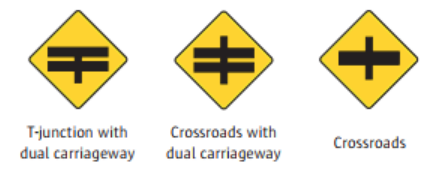
- T-junctions of a dual carriage way
- Crossroads with dual carriage way
- Crossroads
General-purpose warning signs



Warning Signs for Schools and Children
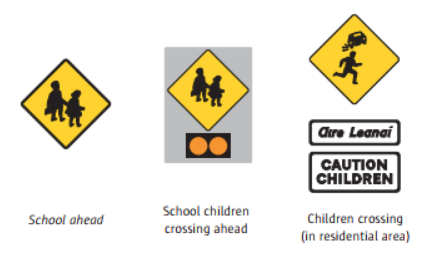
- School ahead
- School children crossing ahead
- Children crossing ahead (in academic area)
- Children crossing ahead (in residential areas)
Tram signs

- Tram lane crossing ahead
- Tram lane warning signs for pedestrians(look right, look left, and look both ways)
- Slippery for cyclists
Warning signs for road works
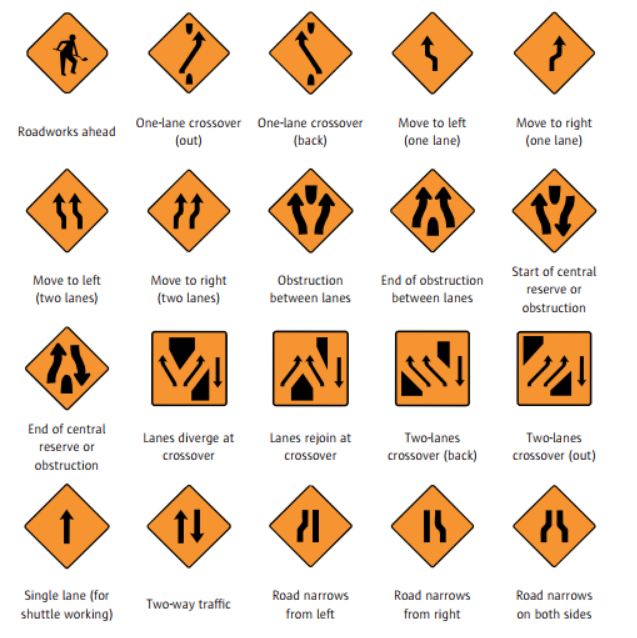
Information plates at road works

3. Information Road Signs
Information Road Signs are usually in rectangular forms and their purpose is to provide guidance and information for drivers; helping them explore interstate roads without having to ask passersby, pedestrians, or fellow road users for directions.
Advance direction signs
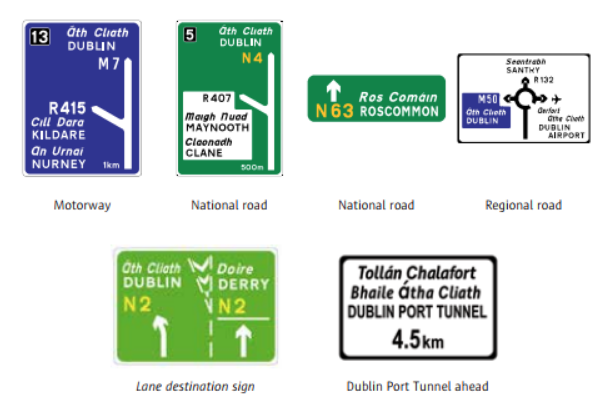
- Motorway
- National road
- National road
- Regional road
- Lane destination sign
- Dublin Port Tunnel ahead
Direction signs at junctions

Tourist information signs
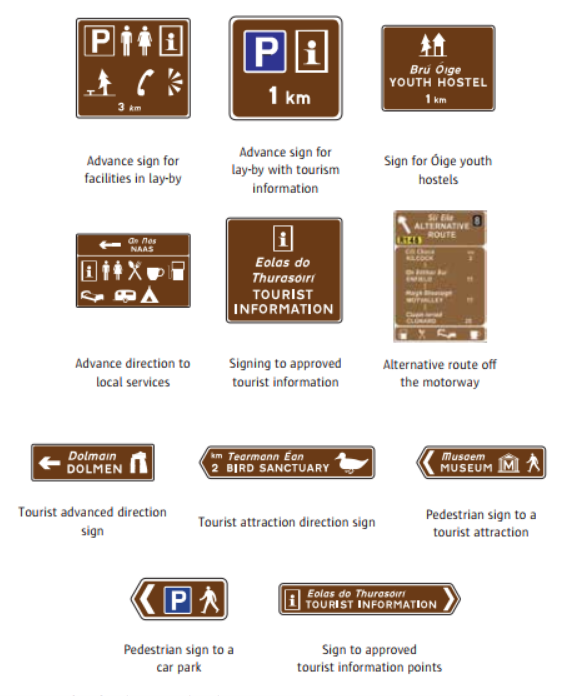
4. Motorway Road Signs
These signs are aimed to help drivers have an idea of the road type they are on and what type of road to expect a few meters away.
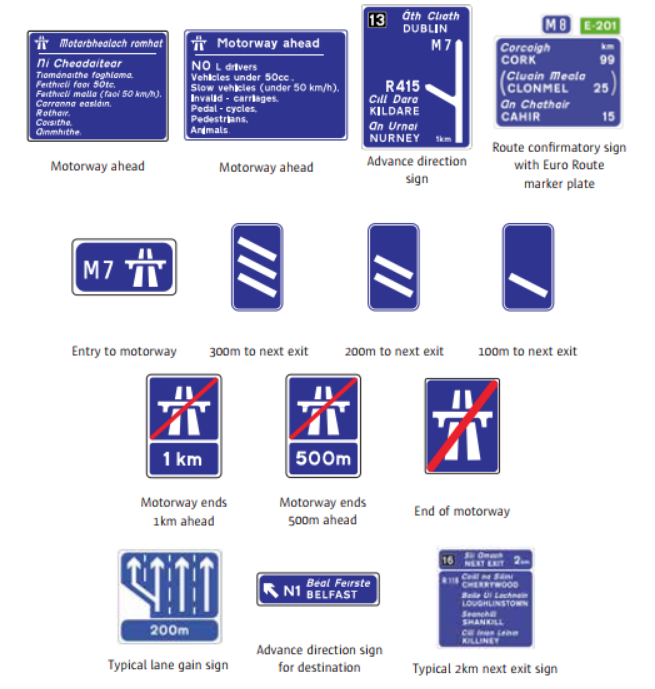
To get a complete list of all Irish Road Signs download your free copy of the Rules of the Road here
